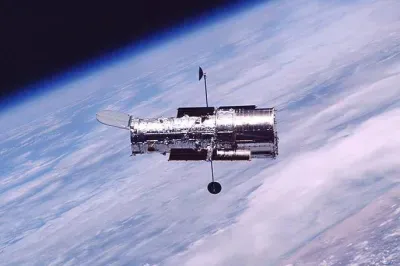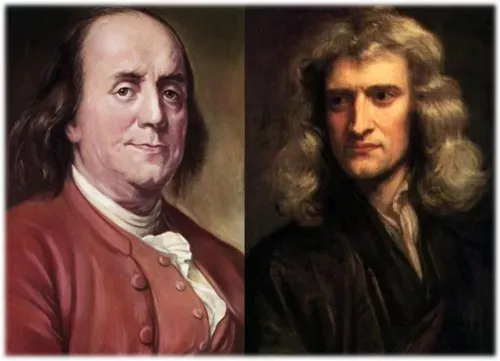Our personal worldviews are shaped early in life, and can be solidified in education. While an undergraduate studying computer engineering 24 years ago, I read a book that molded my own perspective on science, scientists, and politics. It created a philosophical foundation in me that remains today.
As part of my needed “humanities” credits, I took a class called Politics of Science. An assignment was to find, read, and report on a book that discussed some topic concerning politics in science. Perusing my local library, I found The Hubble Wars by Eric Chaisson. Hubble was still a hot topic in 1996, and with my lifelong interest in astronomy, it seemed like an easy fit for the school assignment.
The most profound lesson I took from reading the book? Scientists are human. They can be mad, jealous, even threaten others to defend their territory. This never occurred to me, even though I was nearing the end of an engineering program, which was effectively all calculus and physics and C++, aside from the humanities classes, of course. Learning equations and the names of those who discovered them were “book smarts”. Up to that point in my life, I never really thought about science as a profession, how it generally operates as an internal structure, and how it, and specifically individual scientists, interacts with the world at large.
The Hubble Wars helped shape my worldview. One of my philosophical pillars is that when politics and science mix, it all becomes politics, and politics is driven by money. Like how astrology is anathema to astronomy, politics in an ideal world would stay as far away from science as possible. But politics is that necessary evil which can enable scientific advancement, even though the actual political intentions are never altruistic. This is the lens that I see everything through when politicians invoke science to justify their political agendas. I question everything, and never assume what is presented at face value. I wish more people would do the same, but the opposite seems to be the norm.
There isn’t much available online that I can see by way of discussion and rebuttal to this book. The topic might as well be ancient history here in 2020. Still, it is not hard to imagine that Dr. Chaisson’s account of events was not well-received, and indeed perhaps career inhibiting with regards to NASA and related agencies. The book is still available for purchase on Amazon, and the scant reviews make reference to this, but no sources are cited. Neither Dr. Chaisson‘s Wikipedia page nor Harvard profile mention his Hubble account.
Below is the report I wrote on The Hubble Wars in 1996. It is largely intact outside a variety of minor edits that present-day me did to clean up past-me’s writing, plus a small edit to clarify which President Bush is being referenced, though that is implied by the date of the report.
Hubble Space Telescope Project’s Lack Of Focus
May 9th, 1996
By Paul S. Stelzer
The Space Telescope Project was an initiative started by NASA approximately 20 years ago. The origins of the project may be traced back to 1974, when the National Academy of Sciences recommended the creation of the Space Telescope Science Institute. Simply, the project’s goal was to put a telescope in orbit around the Earth.
There is one primary reason for having a telescope in space: the atmosphere. From thousands of years ago through Galileo’s time and up to the late 1980’s, astronomers had been confined by the layers of gases surrounding the Earth. Further, the atmosphere does not allow ultraviolet light from the universe to reach the ground. Ultraviolet light is crucial to understanding many objects in the Cosmos. In fact, Eric Chaisson, author of The Hubble Wars and member of the Space Telescope Science Institute in the 1980’s and early 90’s, claims there have been only two major advances in telescope astronomy. The first was Galileo’s initial discoveries, and the second was the Hubble telescope.1 With the Hubble Space Telescope, the barrier of the atmosphere has been broken. Astronomers are able to observe the universe with more clarity than ever before.
Aside from the scientific importance of the Space Telescope Project, the political story surrounding Hubble has had a significant impact on large-scale scientific projects in the United States. The first prominent aspect of the Space Telescope Project (also known as the Hubble Project) is its size. Throughout the 20 years of the project, it has employed tens of thousands of workers, had numerous organizations, committees, contractors, and government intervention. All of this has been headed by a weakly-managed and disorganized NASA. The result was many people with many personalities and many agendas, and not much coordination or management, which ultimately hurt the project when it ran into trouble.2
Perhaps not surprisingly, the federal bureaucrats responsible for managing Hubble seemed unconcerned. NASA officials stressed to the workers being part of the “Hubble team”, not realizing that the agency’s version of total quality management damps innovation while promoting mediocrity.3 NASA’s inability to effectively manage the HST Project often made problems worse, while creating disasters with the media.
In the most general scheme of the Hubble Project, three agencies are involved: the Goddard Institute, and the Space Telescope Science Institute, and NASA. The Goddard Institute is the center for Hubble‘s engineers, as well as the location of Hubble Control. The Space Telescope Science Institute, located on the campus of John Hopkins University in Baltimore, Maryland, is responsible for scheduling Hubble‘s activities. The high-level management belongs to NASA, which also controls the Hubble Project’s funding and media relations.
In terms of scientific advice to government, this report considers the Space Telescope Science Institute’s advice to NASA. However, the advice given to government by the Hubble Project as a whole shall be examined first. Why should the government fund such a project? First, there is the previously mentioned reason about scientific research above our atmosphere, but are there any benefits besides this? Clearly, the Hubble Project will not give society a better toaster, or create a new washing machine. Instead, it shall repay the American public with something far more valuable: a renewed interest in science.
Our society is prevalently illiterate of science. To use astronomy as an example, a government-sponsored survey found that nearly one-third of the U.S. adult population thinks that the Sun revolves around the Earth, and an additional 28 percentage do not know it takes a year for our planet to revolve around the Sun.4 While there are many such ‘eye-opening’ statistics like this, they do not help to solve the problem.
Eric Chaisson was the head of the Science Institute’s educational-outreach programs in 1990, when Hubble was launched by Shuttle Discovery. Their target group was, and still is, precollege students. Hopefully, by sharing the rewards of Hubble with students, many will become interested in science, and even enter careers in science or engineering. Obviously, these rewards would be far greater than any single commercial project alone. Shortly before launch of Hubble, a U.S. Senator asked Chaisson what will be the benefits of the Hubble Project, and he gave this fore-mentioned answer. She, and many others, came to believe in this reasoning for the support of Hubble.
To turn this report from the benefits of Hubble, it is important to understand why Chaisson’s book is entitled “The Hubble Wars”. In summary, the relations between NASA and the Science Institute were in a state of chaos in the months following the deployment of Hubble. Before the late-April launch of Hubble in 1990, NASA had over-hyped the Space Telescope Project by claiming things that the telescope could never do. For example, at one NASA press conference they stated that Hubble would be able to see 10 times farther into the universe than from the ground.5 This is false, writes Chaisson, since Hubble cannot see much farther than conventional telescopes. Hubble‘s power lies in its superior resolution and sharpness of images.
In the weeks and months following the launch, the Space Telescope ran into one setback after another. Its initial commissioning period, which was supposed to last only a few weeks, was dragging on into months. From spacecraft jitters to entry into ‘safemode’ (where the spacecraft essentially shuts itself down to some degree), the problems and frustration of Hubble‘s operators steadily grew. This primarily meant the engineers at Goddard, who had to continually uplink software patches to fix problems. NASA didn’t help much with its media relations either. They would always say the telescope was fine, or that they were experiencing only minor problems.6
During this period, the Science Institute continually advised NASA to be truthful about the problems of Hubble. If NASA had been honest with the press by stating that projects of Hubble‘s size were bound to have difficulties during their commissioning period, then perhaps the media would have been more forgiving.7 However, this advice went ignored by NASA. The press knew that NASA was either not being truthful or didn’t know the full situation themselves.
It is interesting to note why the Science Institute did not talk to the press directly. This is because NASA wanted all media relations to go through them. To note one item in particular, whenever an image from Hubble was released to the public, NASA wanted only their logo on it, despite the contributions of Goddard, the Science Institute, and even the European Space Agency, which built several major components of the Space Telescope.8 These actions never faired well with the other agencies.
Tensions came to a climax when NASA had to tell the world that Hubble’s primary mirror was suffering from a spherical aberration, the worst type of optimal defect. The problem was discovered by one of the ESA scientists who specialized in optical physics. From the first pictures taken by Hubble, he calculated that the primary was not the correct shape by 2 microns, or one one-ten-thousandth of an inch. While that does not seem like a large defect, such an error is almost unthinkable in the world the high-precision optics. It would like be making a door that is an inch too wide.
How was such an error overlooked? Quite simply, nobody ever checked the mirror’s dimensions. It was built in 1981 by the Perkin-Elmer Corporation, and remained in an air-tight room for several years before assembly. Through lack of management, it was assumed that the mirror must be the correct size.9
When NASA finally conveyed the news, public opinion of the project worsened considerably. Hubble became the subject of political cartoons, and jokes on late-night television. At this time it was mid-summer, and there was worry that Congress would terminate the project when they reconvened in September. Something had to be done in order to save Hubble.
Chaisson realized that Congress may decide to ‘pull the plug’, and so he wrote a rather stern email letter to everyone at Goddard, the Science Institute, and officials at NASA, pleading that someone take charge of the project. Despite Hubble‘s aberration, many productive pictures could still be taken by Space Telescope with the aid of computer image-cleaning. On this fact, Chaisson recommended that the Early Release Object program (ERO) be reinstated immediately. ERO was meant to have Hubble take several pictures which would be released to the public to show the benefits of the telescope. However, this project was terminated before launch due to the objections of many professional astronomers who didn’t want ‘their’ photos to be seen by ‘street people’.10 Basically, the Universe had been divided by professional astronomers for viewing with Hubble. Each astronomer would have exclusive rights to their pictures for one year, after which they would become public domain. However, given the desperate situation, ERO had to be revived.
A few high-ranking officials took Chaisson’s letter seriously, and ERO was reinstated. Essentially, during August and September of 1990, the Science Institute ignored NASA’s directives and took control of Hubble themselves. They were able to take many pictures which proved that Hubble was not ‘broken’. While several disgruntled astronomers publicly denounced the EROs as a publicity stunt11, the imaging campaign did to some extent restore public support for Hubble, as President (H.W.) Bush showed off a stunning picture of Saturn at the White House. More important, the project was not terminated by Congress in the fall.
Today, several years after the December 1993 Hubble repair mission, public opinion has almost completely reversed. Hubble is now fulfilling its original expectations by unlocking many secrets of the Universe. You can hardly see an astronomy magazine which doesn’t talk about Hubble or show its findings.12 However, the Hubble Project’s downside is that Congress has been much more skeptical about funding large science projects. Projects such as the Mars Exploration and U.S. Space Station (not the international station) have been cancelled13, and non-space related projects such as the Superconducting SuperCollider can trace their termination, at least in part, to Hubble. Despite these setbacks, Hubble is alive and well, and should continue to yield many more fascinating discoveries for well over a decade.
1 “The Hubble Wars”, p25
2 IBID, p30
3 IBID
4 IBID, p31
5 IBID, p352
6 IBID, p116
7 IBID, p169
8 At one point, NASA mailed Chaisson their 12-page booklet containing the official NASA regulations for display of their logo!
9 IBID, p186
10 IBID, p200
11 IBID, p268
12 For an example, see the May 1996 edition on Sky and Telescope.
13 IBID, p350
Bibliography
- Chaisson, Eric J. “The Hubble Wars”, HarperCollins Publishers, New York, NY, 1994
- Sky & Telescope Sky Publishing Corporation, Cambridge, MA, May 1996





